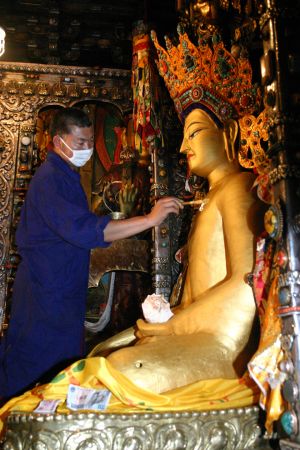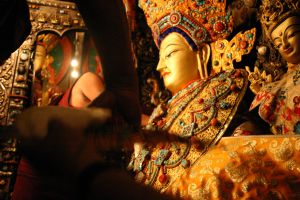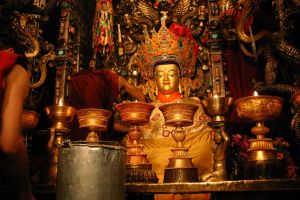JOWO SHAKYAMUNI OF THE RASA TRULNANG TSUKLAKHANG (JOKHANG TEMPLE)
It could be said that the Jowo Shakyamuni of the Rasa Trulnang Tsuklakhang, or Jokhang Temple, is the most famous and least understood object in this book. Despite its long history and ubiquity throughout Tibetan culture, as well as current popularity, many misperceptions of it abound, fundamental questions are unanswerable, and more often than not, it serves as a mirror of the investigator more than the source of new knowledge.
THE JOWO
In Tibetan, the term can mean “older brother” or “Lord” (in both the secular and religious senses), but most often, the term refers to the Jowo Shakyamuni of the Rasa Trulnang Tsuklakhang: that Jowo is Buddha Shakyamuni depicted in his celestial form, dressed in royal garments, not the wandering mendicant we are more used to seeing.1
However, there have been many Jowos in Tibetan history. Some were men. Some were Buddhist statues. Of the Buddhist statues, some have little to no connection with the one in the Rasa Trulnang Tsuklakhang. Others have their own features and histories, but they are connected to this Jowo through Tibetan mythological texts of the eleventh through thirteenth centuries CE that explain each statue’s purpose for existence and genealogy.2
Many Jowos are copies made of this Jowo, whether they be the same or different size, whether they be in Tibet or in another country, whether they are statues or photographs. For example, many ancient copies of the Jowo can be found hundreds of miles from Lhasa in parts of eastern Tibet, such as at the Sakya Monastery called Ba Lhagang in the Ganzi Tibetan Autonomous Prefecture, Sichuan Province. Copies can be found in other countries, such as at Tharig Monastery in Kathmandu, Nepal, or the Drigung Meditation Center in Arlington, Massachusetts, in the United States.
Photographs of the present Jowo are ubiquitous across the Tibetan Plateau on home shrines, in restaurants, and over the cash registers in businesses. A unique and notable photograph can be found in the alcove next to the Dalai Lama’s throne in the Tekchen Choling Tsuklakhang, the temple that serves as a national cathedral for exiled Tibetans in McLeod Ganj, Dharamsala, Himachal Pradesh, India. Taken in the early 1950s by a team of Czech photographers, Vladimír Sís and Josef Vanis, it is the last known photograph of the Jowo made before the Dalai Lama fled into exile in 1959. In the Sís and Vanis photograph (fig. 2), the Jowo’s face is very thick and uneven, caked over with centuries of gold paint (drangser), which was allegedly removed in the 1960s by Red Guards during the Cultural Revolution.3
In European languages, when one refers to “the Jowo,” it designates the Jowo Shakyamuni, the subject of this essay. In Tibetan, he would most often be referred to as “Jowo Rinpoche,” meaning “the Precious Lord,” but also the Jowo Shakyamuni, the Jowo Chomdende, even “the elder brother,” or simply “the Lhasa Jowo,” in order to distinguish the template from all of its scattered copies. Never using the many Tibetan words for statue, Tibetans have written and spoken about the Jowo as equivalent to a very holy person, not as an object. Countless miracles have been attributed to the Jowo in
Tibetan biographies and autobiographies, mainly in the form of dreams or visions of him speaking, shining light rays, or moving. Some of these miracles serve as narratives to explain points of Buddhist doctrine, such as the power of faith; others have changed the course of Tibetan history, such as the Jowo explaining to the Fifth Dalai Lama (1617–1682) that he was a reincarnation of the Tibetan emperor Songtsen Gampo (ca. 605–649).
But what or who is the Jowo? According to biographies of the Jowo that emerged in Tibetan literature around the eleventh through thirteenth centuries CE, he is a portrait-from-life of the historical Buddha Shakyamuni executed by Vishvakarma, the divine craftsman of Indian cosmology, during the Buddha’s lifetime (ca. 500 bce) and at the Buddha’s command, and yet not a portrait, as the size of the Jowo comes from the memory of what Siddhartha Gautama (the man who became the Buddha) looked like at age twelve according to the memory of his nursemaid.4 According to those biographies, the
historical Buddha Shakyamuni intended for a proxy (kutsab) with his likeness and powers to reside in Tibet in his stead, in order to subdue Tibetans and help Avalokiteshvara guide them on the Buddhist path.5 In that sense, elements of the Jowo Shakyamuni’s biography resemble the biographies of other supposed “first” images of the Buddha found in nearly every Buddhist country in Asia, such as Xuanzang’s Uddiyana Buddha, the Seiryoji Shaka in Japan, or the Emerald Buddha of Thailand.
THE JOWO AS AGENT OF CHANGE: THE PERSPECTIVE OF TIBETAN HIERARCHS
A judicious reading of Tibetan historiography would conclude that the mythopoetic biography of the Jowo and the physical object arrived in Tibet separately. That is, we know much more about what Tibetans have written regarding the Jowo Rinpoche than we know about the statue itself. While the physical object might have arrived about 641, it was not called “the Jowo” or treated as a portrait of the Buddha until at least the eleventh century CE.6
Perhaps the earliest signs of what later came to be known as the Jowo appear in The Testament of Ba, which records that a Chinese “princess,” Wencheng Gongzhu (d. 680), brought a “golden god” to Lhasa in 641 as part of her dowry for her marriage to Songtsen Gampo.7 Not only is that golden god not called “the Jowo,” but also the descriptions of its physical form and miraculous activities do not accord with the later Jowo Shakyamuni. For example, the present Jowo is slightly larger than life-size, but The Testament of Ba states that Wencheng Gongzhu’s retinue brought “the golden god”
from China “in the lap of one horseman.” And in another passage, the death of an anti-Buddhist government official is attributed to “the Chinese God” being angry.8 Centuries later, across a range of texts, Tibetan religious historiographers presented a fully formed biography of the Jowo Shakyamuni identified with that same dowry image from Wencheng Gongzhu.9 The complex of beliefs and practices around the Jowo described in those texts, such as making offerings, painting the face with gold, and associating him with Avalokiteshvara and the rulers of Tibet, later grew as nearly all prominent religious leaders in Tibet paid homage to the Jowo and reconceptualized their own position in Tibetan society vis-à-vis visionary experiences they reported to have received from him.
Early Kadampa and Kagyupa hierarchs wrote of the Jowo’s importance to Lhasa, as well as his connection to the former Tibetan Empire (ca. 608–866) and the conversion of Tibet to Buddhism. One of them, Zangkar Lotsawa Pakpa Sherab Pel, in the late eleventh century renovated the Rasa Trulnang Temple, placing the Jowo in the Central Chapel, called the Jokhang (literally, house of the Jowo). His disciples and their later followers continued to add to the temple and received visions from the Jowo while simultaneously tightening their grip on Lhasa and the governance of central Tibet. The
pattern of lamas pairing veneration of the Jowo with political rule of Tibet continued for centuries. For example, the founder of the Gelukpa tradition, Tsongkhapa (1357–1419), placed a crown on the head of the Jowo in 1409 and instituted the annual celebration of the Great Prayer Festival. Placing a crown on the Jowo’s head controversially changed the Jowo’s iconography, which later generations deemed an extreme act of sectarianism.10 And later, when the Fifth Dalai Lama promulgated his new Ganden Podrang government, he recorded in his autobiography a series of visions he received from the Jowo confirming him as the latest birth in a line of embodiments of Avalokiteshvara that stretched back to Songtsen Gampo.
THE JOWO’S PRESENT POPULARITY AND SIGNIFICANCE
Each time someone has paid homage to the Jowo, it has reinforced him as the imprimatur of authenticity bar none. Even when the Communist Party of China officially selected Gyaincain Norbu to be the Panchen Lama in 1995, lamas performed the Golden Urn ceremony in front of the Jowo to confer legitimacy on the proceedings.11 From the perspective of the Communist Party, the Jowo symbolically and indexically represents China’s long benevolent relationship toward Tibet beginning with Wencheng Gongzhu and continuing today.12 Therefore, because of its immense significance for the narrative Communist authorities desire to project, independent material analysis of the Jowo is impossible.
THE MATERIALITY OF THE JOWO
Some of the most compelling questions Tibetans have asked about the Jowo are those regarding the nature of materiality itself, the role it ought to play in Buddhist practice, and the part it has played in Tibetan politics and governance. For example, as the Buddha’s portrait made-from-life and his proxy, what is the relationship between his appearance and his powers? If one were to change the Jowo’s appearance, would that affect his powers? If he is a portrait-from-life, should not all paintings and statues of Buddha Shakyamuni in Tibet look like the Jowo, that is, share his
iconometric measurements? Can average people even see the “real” Jowo, or does one have to be an advanced practitioner of tantric Buddhism? The only information we know for certain about the physical object currently in the Rasa Trulnang Tsuklakhang is that frequently performed rituals of both veneration and physical restoration, such as the application of gold paint (fig. 3) and the regular changing of the crown, ornaments, and clothing (fig. 4 and 5), have morphed the outer appearance of the Jowo.
The current popularity of these rituals among increasingly wealthy pilgrims who want to generate religious merit (sonam) means the Jowo’s appearance is still shifting in front of our eyes. Though historical sources preserve testimony to multiple attacks on the site every few centuries, as well as periodic restorations of the temple, there is no way to determine whether the present Jowo is the one Wencheng brought with her, a later replacement, or was newly fabricated after the end of the Cultural Revolution. However, we can say for certain that based on his presence in pop culture and the number of visits to his temple, the Jowo’s popularity has not diminished.
Source
Wikipedia:JOWO SHAKYAMUNI OF THE RASA TRULNANG TSUKLAKHANG (JOKHANG TEMPLE)


